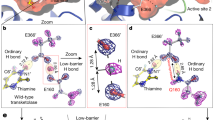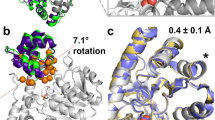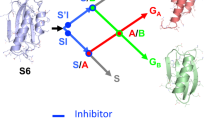Abstract
Two historic publications have suggested that enzymes can utilize the binding energy with their substrates to increase the rate of chemical catalysis—a concept termed strain1,2. Specifically, the structure of an enzyme was described as complementary to the structure of the transition state of its substrate rather than to that of the unreacted substrate, so that the substrate would tend to be distorted on binding to the enzyme. The current understanding of strain does not require such distortion. Instead, it is thought that there are groups on the enzyme which interact better with the transition state than with the unaltered substrate, an arrangement known as differential binding of substrates and transition states3. The improvement in binding energy caused by going from substrate to transition state lowers the activation energy of the reaction and so increases the catalytic rate. Here we report direct evidence in support of this notion. Rapid reaction kinetics on mutants of a tyrosyl-transfer RNA synthetase produced by protein engineering show that certain hydrogen-bonding side chains some distance from the reacting bonds of the substrate bind to ATP preferentially in the transition state of the reaction rather than in the unreacted state. In this way, the binding energies of the interactions are used primarily to lower the apparent activation energy of the chemical steps rather than to enhance binding.
This is a preview of subscription content, access via your institution
Access options
Subscribe to this journal
Receive 51 print issues and online access
$199.00 per year
only $3.90 per issue
Buy this article
- Purchase on Springer Link
- Instant access to full article PDF
Prices may be subject to local taxes which are calculated during checkout
Similar content being viewed by others
References
Hadane, J. B. S. Enzymes 2nd edn (MIT Press, Cambridge, 1965).
Pauling, L. Chem. Engng News 24, 1375–1377 (1946).
Fersht, A. R. Enzyme Structure and Mechanism 2nd edn, Ch. 12 (Freeman, New York, 1985).
Fersht, A. R. et al. Nature 314, 235–238 (1985).
Wilkinson, A. J., Fersht, A. R., Blow, D. M., Carter, P. & Winter, G. Nature 307, 187–188 (1984).
Carter, P., Winter, G., Wilkinson, A. J. & Fersht, A. R. Cell 38, 835–840 (1984).
Jones, M. D., Lowe, D. M., Borgford, T. & Fersht, A. R. EMBO J. (submitted).
Fersht, A. R., Mulvey, R. S. & Koch, G. L. E. Biochemistry 14, 13–18 (1975).
Waye, M. M. Y., Winter, G., Wilkinson, A. J. & Fersht, A. R. EMBO J. 2, 1827–1829 (1983).
Author information
Authors and Affiliations
Rights and permissions
About this article
Cite this article
Wells, T., Fersht, A. Hydrogen bonding in enzymatic catalysis analysed by protein engineering. Nature 316, 656–657 (1985). https://doi.org/10.1038/316656a0
Received:
Accepted:
Published:
Issue Date:
DOI: https://doi.org/10.1038/316656a0
This article is cited by
Comments
By submitting a comment you agree to abide by our Terms and Community Guidelines. If you find something abusive or that does not comply with our terms or guidelines please flag it as inappropriate.



